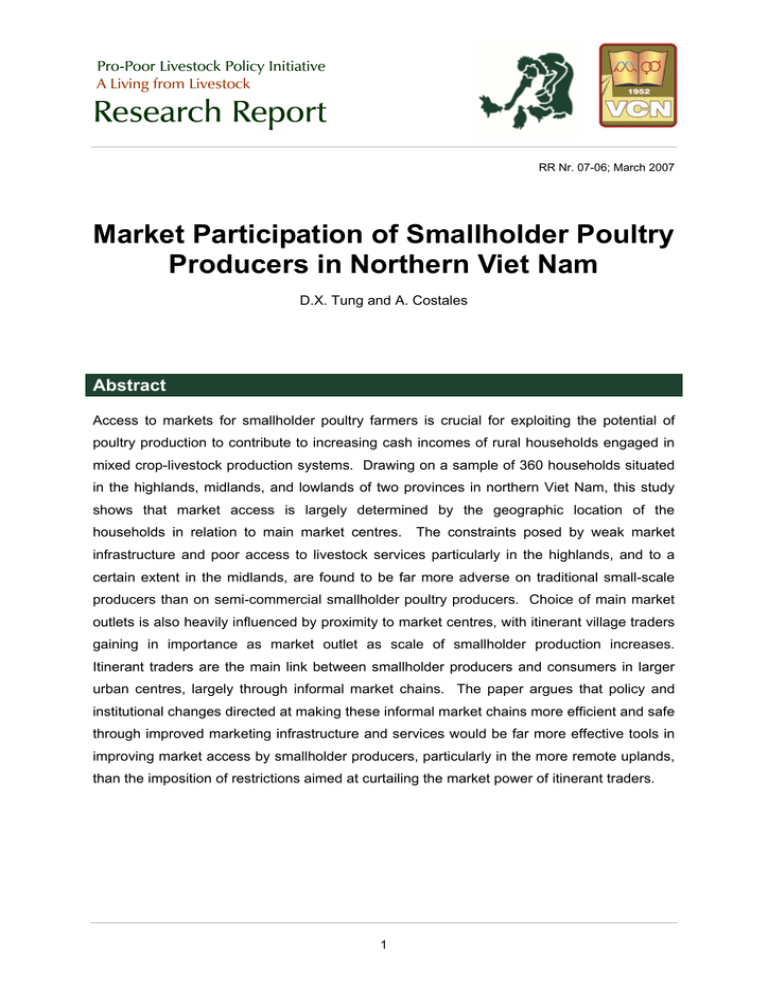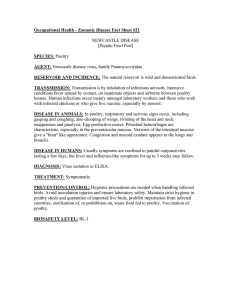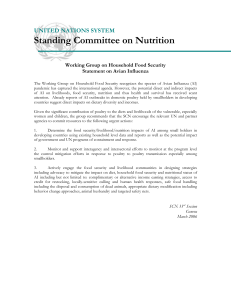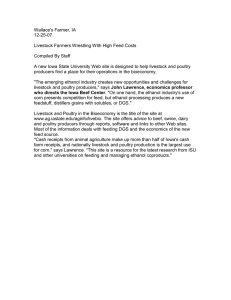Research Report Market Participation of Smallholder Poultry Producers in Northern Viet Nam Abstract
advertisement

Pro-Poor Livestock Policy Initiative A Living from Livestock Research Report RR Nr. 07-06; March 2007 Market Participation of Smallholder Poultry Producers in Northern Viet Nam D.X. Tung and A. Costales Abstract Access to markets for smallholder poultry farmers is crucial for exploiting the potential of poultry production to contribute to increasing cash incomes of rural households engaged in mixed crop-livestock production systems. Drawing on a sample of 360 households situated in the highlands, midlands, and lowlands of two provinces in northern Viet Nam, this study shows that market access is largely determined by the geographic location of the households in relation to main market centres. The constraints posed by weak market infrastructure and poor access to livestock services particularly in the highlands, and to a certain extent in the midlands, are found to be far more adverse on traditional small-scale producers than on semi-commercial smallholder poultry producers. Choice of main market outlets is also heavily influenced by proximity to market centres, with itinerant village traders gaining in importance as market outlet as scale of smallholder production increases. Itinerant traders are the main link between smallholder producers and consumers in larger urban centres, largely through informal market chains. The paper argues that policy and institutional changes directed at making these informal market chains more efficient and safe through improved marketing infrastructure and services would be far more effective tools in improving market access by smallholder producers, particularly in the more remote uplands, than the imposition of restrictions aimed at curtailing the market power of itinerant traders. 1 PPLPI Research Report 1. Introduction Poultry production is an integral part of the mixed crop-livestock farming system practiced by most rural households in Viet Nam, where it performs an important function through the provision of meat and eggs for home consumption and for the generation of cash income through market exchange. Rather than being a specialized enterprise constituting the main source of income among rural farm households, poultry husbandry is more commonly a supplementary source, complementing the income flows from the production of staples, cash crops, and other livestock, most commonly pigs. Traditional poultry production commonly involves keeping of not more than 50 chickens at any given time, mostly of local breeds, with scavenging on garden plots being the dominant mode of feeding. Alongside these traditional small-scale producers there exists a minority of rural farm households with a larger scale of operation, raising more than 50 chickens at a time, using ‘exotic’ chicken breeds and more intensive feeding regimes (e.g. feed-grains and prepared feeds). The distribution of poultry raising households and the average flock sizes in Viet Nam are depicted in Figures 1a and 1b. Figure 1a shows the proportion of households engaged in poultry husbandry by commune while Figure 1b displays the average poultry flock size per household across communes in Viet Nam. Fig. 1a. Proportion of rural households keeping poultry by commune Fig. 1b. Mean size of poultry flock per household by commune Source: M. Epprecht (2006) 2 PPLPI Research Report location and agro-ecological conditions of the farm, and on the infrastructural and institutional endowments of the commune, particularly in terms of access to markets and services. Figure 1a shows that, in general, a higher proportion of households are engaged in poultry production in the northern than in the southern regions of Viet Nam. In the North, in many communes between 75 and 90 percent of households keep poultry and, in some communes, even more than 90 percent of households keep poultry. The two large delta regions (Red river in the North and Mekong river in the South) are major poultry production areas. In terms of scale of production, Figure 1b shows that, in general, poultry flocks of more than 50 chickens are more prevalent in the Mekong river delta than in the Red river delta, indicating a greater prevalence of smallholder poultry producers in northern Viet Nam than in the South of the country. The marketing of poultry products offers an opportunity for smallholder producers to increase their small cash incomes. However, market access is crucial for realization of this opportunity. This paper presents the results of a survey carried out in 2003 with the aim of assessing the extent to which smallholder poultry producers in northern Viet Nam participate in the markets for poultry products, their main market links, the advantages of using particular market links, and the barriers that they face in attempting to capitalize on market opportunities. 2. Sample Selection A sample of smallholder poultry producers was drawn from the provinces of Thai Binh and Thanh Hoa, the major poultry producing region in northern Viet Nam. Three categories of locations were distinguished to represent differences in agro-ecological conditions, as well as in infrastructural and institutional endowments of communes in terms of access to markets and services. The three locations were categorized as Highland, Midland, and Lowland. Farm households in the highlands were deemed to have the least access to markets and services, while those in the lowlands were deemed to have the best access compared to the other two location categories. Smallholder producers were classified into two categories according to scale and type of operation, namely (a) ‘small-scale traditional’ and (b) small-scale ‘semi-commercial’ producers, respectively. Categorization was based on two simple criteria: scale of production and feeding regime. On the one hand, small-scale traditional producers encompassed households that did not keep more than 50 chickens at any time, and used a feeding regime predominantly based on allowing birds to ‘scavenge’ (although some feed-grains may be used from time to time). On the other hand, small-scale semi-commercial producers encompassed households with flocks of 3 PPLPI Research Report more than 50 birds at any one time, using a feeding regime predominantly based on the use of feed-grains and mixed feeds (although some scavenging may still be practiced). A structured sampling frame was used to obtain 360 sample households, consisting of 270 smallscale traditional producers and 90 small-scale semi-commercial poultry producers. Table 1 shows the sample structure by scale and location. Table 1: Sample composition of smallholder poultry producers in Thai Binh and Thanh Hoa provinces, northern Viet Nam SCALE Small-scale traditional (≤ 50 birds) Semi-commercial (> 50 birds) Total Highland 90 30 120 Midland 90 30 120 Lowland 90 30 120 Total 270 90 360 Forty-five (45) traders in the two provinces were also interviewed to complement marketing information provided by the sample households and to construct the poultry market chains. 3. Production, Home Consumption and Market Participation Smallholders raise poultry for meat and eggs and income generated is the combined value of produce in form of live birds and eggs. The value of produce, both used for home consumption and marketed surplus, of the sampled poultry farms over a 1-year period was calculated as the market value of live chicken and eggs produced and consumed or sold, and converted into US dollars (the exchange rate used was VND 15,700 to USD 1). The value of produce and the share of marketed surplus and home consumption by farm type and location are presented in Figure 2. 4 PPLPI Research Report Figure 2: Value of produce, marketed surplus and home consumption of small-scale traditional and semi-commercial poultry producers by location in Thai Binh and Thanh Hoa, 2003. 600 500 USD/yr 400 Home consumption Marketed surplus 300 200 100 Highland Midland Lowland Highland Small-scale Traditional (≤ 50 birds) Midland Lowland Semi-commercial (>50 birds) Value of poultry produce across farm types and locations Among the group of small-scale traditional producers, the value of produce exhibits a clear pattern with the mean value of produce per farm increasing from the highlands to the lowlands. Among the semi-commercial smallholders, the only finding consistent with the first group is that the mean value of produce is lowest for farms located in the highlands. This is likely to indicate that the more difficult agro-ecological conditions and limited infrastructural and institutional endowments in the highlands have a strong negative impact on the produce performance of poultry producers, irrespective of whether they are small-scale traditional or semi-commercial. Market sales and home consumption In absolute terms, the value of poultry produce sold by traditional small-scale producers increases steeply from the highlands over the midlands to the lowlands, while the value of home consumed poultry produce is similar in the highland and midland farms, but virtually nil among the lowland farms. Among the semi-commercial smallholders, the pattern in value of produce sold across locations is very similar to the total value of poultry produce, with the value of marketed surplus being smallest among semi-commercial producers in the highlands. In the lowlands, with good market access, semi-commercial smallholders tend to divert very little of their poultry produce to home consumption, similar to the pattern observed in traditional smallholders. 5 PPLPI Research Report Figure 3 shows the differences in the proportion of marketed produce across farm types and locations. Cast in relative terms, clear patterns emerge. First, for both traditional and semicommercial smallholder producers, the proportion of produce sold increases from the highlands to the lowlands. Second, between the two groups, the rate of increase in the proportion of produce marketed is more marked among the traditional producers, which may imply that the difficulties posed by infrastructural and institutional constrains present higher barriers to market participation for the latter than for the semi-commercial farmers. Figure 3: Proportion of poultry produce sold by small-scale traditional and semi-commercial poultry producers by location, Thai Binh and Thanh Hoa, 2003. 100% 90% Share in total output 80% 70% 60% Home consumption 50% Marketed surplus 40% 30% 20% 10% Small-scale Traditional (≤ 50 birds) Lowland Midland Highland Lowland Midland Highland 0% Semi-commercial (>50 birds) The very high proportion of marketed poultry produce (and corresponding low rates of home consumption) by smallholder poultry producers in the lowlands, whether small-scale traditional or semi-commercial, clearly indicates the advantages of proximity to markets and market centres. Not only can poultry produce be sold more easily, but other food items can also more easily be purchased from the derived income. 4. Smallholder Market Outlets and Marketing Chains Smallholder producers use three main market outlets for their poultry products. They sell their produce at the farmgate to itinerant traders (collectors / assemblers), take their products to the local commune market, or sell to other farmers in the village. The largest share (47%) of the poultry produce is sold to itinerant traders, while sales in the commune markets rank second 6 PPLPI Research Report (38%). The sale of some chickens or eggs to other villagers is generally more motivated by the desire to maintain good social relations rather by financial considerations. From the main market outlets for the farmers, the poultry products flow through various chains and channels, until they reach the final consumer. Figure 4 illustrates the market chains for poultry produce of smallholders in the provinces of Thai Binh and Thanh Hoa. Most (64%) of the produce bought by itinerant traders are delivered to wholesale traders, who in turn, deliver most of their merchandise (73%) to retailers in larger cities and towns. When products are brought to the local commune market, local retailers are the main buyers (54%), who in turn sell to local consumers. Figure 4: Market outlets and market chains of smallholder poultry producers in Thai Binh and Thanh Hoa, 2003. Poultry Farmers 38% 15% 47% Neighbors/Villagers (farmgate) Itinerant Village Traders (farmgate) Local/Community Market (18%) (18%) (64%) Wholesalers (19%) (54%) (27%) 73% Retailers 7% 93% Other intermediaries CONSUMERS Source: Field survey, 2003 7 27% PPLPI Research Report Although Figure 4 depicts distinct intermediaries and product flows along the informal market chains in northern Viet Nam, there are instances where the role of actors labelled as ‘wholesalers’ or ‘retailers’ are actually not restricted to the functions that these market intermediaries play in formal markets as standard nomenclature connotes. 5. The Choice of Market Outlet by Smallholders In the marketing of poultry produce, smallholders may use all three main market outlets, but in different degrees, and perhaps for different purposes. Figure 5 shows that the relative dominance of a particular market outlet is more strongly associated with geographic location than with scale of activity, where location may be indicative of proximity to local market centres. Figure 5: Relative dominance of market outlets for smallholder poultry producers in Thai Binh and Thanh Hoa, by location, 2003. 100% 90% Percent of outpput 80% 70% 60% Commune open market 50% Itinerant traders at farmgate 40% Village neighbours 30% 20% 10% 0% ≤50 birds 50+ birds ≤50 birds Highland 50+ birds ≤50 birds Midland 50+ birds Lowland In general, among smallholder producers located in the highlands, the bulk of poultry produce is sold to village neighbours, followed by sales to itinerant traders. In contrast, smallholders in the lowlands take the largest part of their produce to the local markets and only sell a very small share to other households in the village. In the midlands, itinerant traders are the dominant outlet for both types of smallholders. For a given location, the share of produce sold to itinerant traders increases as scale of production expands. In the highlands, this comes at the expense of produce sold to neighbours, while in the lowlands and the midlands, this comes at the expense of produce sold in the local markets. While the reduction in the share of sales to neighbours in the uplands is expected, the decrease in share of produce sold in the local markets in the lowlands and the midlands is not 8 PPLPI Research Report easily explained. Conventional wisdom would suggest that farmers take their produce to the local markets to obtain a higher price for their produce than the price offered by itinerant traders, particularly when the amount of produce is sufficiently large to lower the unit transaction costs of taking produce to the commune market. What the above results indicate, however, is that as scale expands, selling produce to itinerant traders at the farm gate offers the relatively greater advantage. This appears to be validated by the comparison of prices received from itinerant traders and from buyers in the local markets presented in the next section. 6. Prices Received from Itinerant Traders and from Buyers in the Local Markets Prices (in US $) received in 2003 per kilogram liveweight of chicken by smallholders from traders at the farmgate and from buyers in the local markets in the study locations are shown in Figure 6. Figure 6: Prices received from itinerant traders at the farmgate and from buyers in the commune markets in the provinces of Thai Binh and Thanh Hoa, 2003 1.6 USD/kg liveweight 1.4 1.2 1.0 Itinerant traders 0.8 Local open market 0.6 0.4 0.2 ≤50 birds >50 birds* Highland ≤50 birds >50 birds Midland ≤50 birds >50 birds* Lowland With the exception of semi-commercial poultry producers in the midlands, prices received from itinerant traders at the farm gate were higher than those received from buyers in the commune markets. These unexpected results may have to be interpreted within the context of commune markets in rural northern Viet Nam being small local markets serving the surrounding communities with relatively low purchasing power. This is in contrast to the markets supplying smaller towns and larger cities with more and better-off consumers, able and willing to pay higher prices. Following these considerations, poultry produce purchased from smallholders by itinerant 9 PPLPI Research Report traders is likely to be destined for urban consumers, passing through larger wholesale traders, and processed and distributed by the retailers in the larger urban markets. Along this market channel, the produce purchased by the itinerant traders from the rural smallholder producers would somehow have been ‘screened’ to fulfill the requirements set by their wholesale buyers. The other side of the coin possibly is that the poultry produce taken to the local markets predominantly consists of produce left unpurchased / rejected by the itinerant traders. If this is the case, taking the remaining marketable surplus to the local market is the second best option, and a producer would be willing to receive a lower price for this produce rather than taking it back home again. This line of argument would explain why itinerant traders offer higher prices to smallholder chicken producers than these obtain in the local markets, and one would expect that the difference in price increases as scale of production expands. 7. Relative Bargaining Position of Small-Scale Traditional and Semi-Commercial Producers Larger-scale producers are thought to generally have greater bargaining power than smallerscale producers, translating into higher prices for the same type of product. This study appears to confirm the above even within different smallholder classes both for eggs and live birds. For eggs, small-scale semi-commercial producers received slightly higher prices than their traditional counterparts, and the same holds true for live chicken (see Figure 7). Furthermore, the differences in mean prices received by small-scale traditional and semi-commercial producers were relatively larger in the highlands and midlands, and in these locations, the differences were statistically significant. Thus, there appears not only to be a scale dimension in the ability to obtain higher prices for the same produce than other producers, but also a locational dimension. The significant differences in mean prices received by small-scale traditional and semi-commercial producers in the highlands and midlands seem to indicate that in locations where the infrastructural and institutional endowments for market access are poorer, the significance of supply volume in providing bargaining power by smallholders vis-a-vis market intermediaries is amplified. This appears to be the case especially when dealing with the itinerant traders. In the midlands where the itinerant traders were the dominant market outlet, the average price advantage of the semicommercial producers was more than 11 percent. 10 PPLPI Research Report Figure 7: Differences in prices received per kilogram of chicken by small-scale traditional and semi-commercial producers in Thai Binh and Thanh Hoa provinces, 2003 1.6 1.4 USD/kg liveweight 1.2 1.0 Small-scale traditional (≤50 birds) Semi-commercial (>50 birds) 0.8 0.6 0.4 0.2 0.0 Highland* Midland* Lowland Figure 7 also provides information on differences in prices received by smallholders across geographic locations by scale of operation. The conventional expectation would be that prices received improve as one moved from the remote regions to the locations close to the larger market centres. This expectation, however, is not borne out by the results in its entirety. While it is the case that prices received by smallholders in the lowlands were higher than those received by those in the midlands within type of smallholder, this relation did not hold between producers from the highlands and those from the midlands. Within smallholder producer type, producers in the highlands received higher prices per kilogram of chicken than their counterparts in the midlands. A possible explanation for this surprising result may lie in differences in the demand and supply balances between the study locations. In follow up investigations based on the observed direction of poultry trade flows, the midlands referred to in this study were found to be net sellers of chicken, while the highlands were observed to be net buyers. (As noted previously, the dominant market outlets for smallholder chicken in the highlands were final consumers). Thus, given the trade flow of poultry from the midlands to the highlands, prices can be expected to be lower in the midlands, the supply source, than in the highlands. 11 PPLPI Research Report 8. Sources of Market Information and Main Problems Faced by Smallholder Poultry Producers Once smallholders increase their degree of market orientation, itinerant traders generally become their main link to the mainstream markets for poultry products supplying the larger urban centres. Figure 8 shows that except for small-scale traditional producers in the highlands, traders are the main source of market information for smallholder producers across locations. Figure 8: Main sources of market information of smallholder poultry producers in the provinces of Thai Binh and Thanh Hoa, 2003. 100% 80% 60% Radio/TV Neighbours Traders 40% 20% 0% ≤50 birds >50 birds Highlands ≤50 birds >50 birds Intermediate regions ≤50 birds >50 birds Lowlands As smallholders move to a higher scale of production and market orientation, the importance of traders increases and the role of neighbours as main source of market information diminishes. Radio and TV are still a very minor source of information and only accorded some importance by semi-commercial smallholder producers in the lowlands. Figure 9 shows the perceptions of smallholder producers about their main problems in marketing poultry produce. Across locations and production scale, the majority of smallholder producers (70%) view unstable market conditions for poultry, reflected in price fluctuation, as their main problem in the marketing of their products, while less than a third view trader dominance as the main problem. Trader dominance is regarded more of a problem among the traditional smallholder producers (31%) than among the semi-commercial smallholders (23%). 12 PPLPI Research Report Figure 9: Smallholder perception on main problems in marketing of poultry produce in the provinces of Thai Binh and Thanh Hoa, 2003. Percent of households 100% 80% Other 60% Trader dominance 40% Market price fluctuations 20% Small-scale Traditional (≤50 birds) Lowlands Midlands Highlands Lowlands Midlands Highlands 0% Semi-commercial (>50 birds) 9. Conclusions • Traditional smallholder poultry producers are market-oriented and sell a large share of their poultry produce when given the opportunity (as seen in the midlands and lowlands). • Market infrastructure and institutional aspects of market access are crucial for improving opportunities of smallholders for increased market participation. • In addition to determining market orientation, infrastructural and institutional conditions have a significant bearing on scale of smallholder production. • Local commune markets in rural areas (where most households keep their own poultry) are too small to absorb smallholder poultry produce, particularly when smallholders begin to expand scale to semi-commercial levels (>50 birds per household). • Itinerant village traders are the main link between smallholders and the mainstream markets supplying larger urban centres. They become the most important outlets for smallholders as these expand production scale and offer more attractive prices per kilogram of produce than other outlets. • General or local market instability, manifested in unpredictable price fluctuations, has far larger negative impacts on the livelihoods of smallholder poultry producers than dominance of traders (at least from the viewpoint of poultry producers, whether small-scale traditional or semi-commercial). • Without better alternatives to the informal market channels mediated by itinerant traders, market development for smallholders should focus on improving market institutions that 13 PPLPI Research Report increase market access and bargaining power of smallholders, rather than narrowly focusing on reducing the margins earned by traders along the marketing chain. Contacts and Disclaimer PPLPI Research Reports have not been subject to independent peer review and constitute views of the authors only. This report is an excerpt of Chapter 9 of the draft dissertation “Poultry Marketing in Vietnam” of D.X. Tung, submitted to Food and Resource Economics Institute, University of Copenhagen, Copenhagen, Denmark, in 2007. For comments and / or additional information, please contact: Din Xuan Tung National Institute of Animal Husbandry (NIAH) Head, Dpt. of Economics and Farming Systems Hanoi, Viet Nam E-mail: dxtung168@hotmail.com NIAH website at: www.vcn.vnn.vn Achilles Costales Livestock Economist Pro-Poor Livestock Policy Initiative (PPLPI) FAO - Animal Production and Health Division Viale delle terme di Caracalla, 00153, Rome, Italy E-mail: achilles.costales@fao.org Or visit the PPLPI website at: www.fao.org/ag/pplpi.html 14





